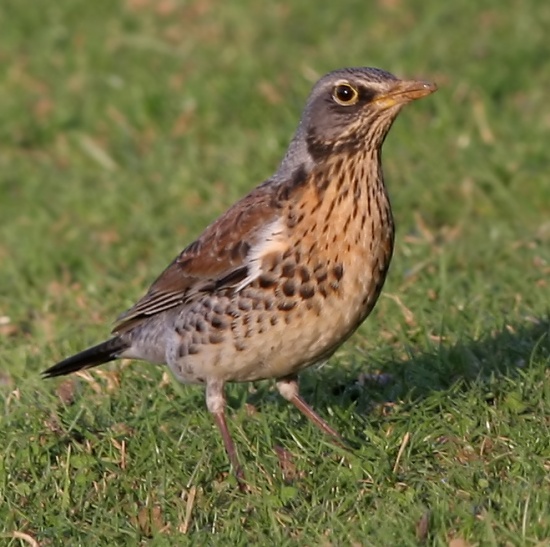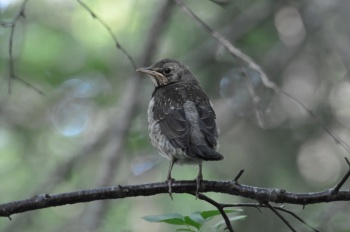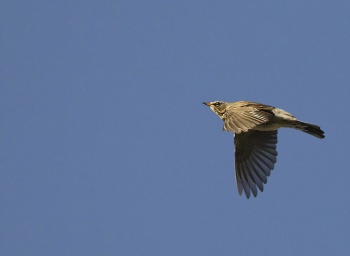(→External Links: Video Search added) |
(→External Links: New Video search created) |
||
| (3 intermediate revisions by the same user not shown) | |||
| Line 59: | Line 59: | ||
==External Links== | ==External Links== | ||
| − | + | {{GSearch|"Turdus pilaris" {{!}} "Fieldfare"}} | |
| − | {{GSearch|Turdus | + | <br /> |
| − | + | {{VSearch|"Turdus pilaris" {{!}} "Fieldfare"}} | |
| − | + | {{GS-checked}}1 | |
| − | |||
| − | {{ | ||
| − | {{GS-checked}} | ||
<br /> | <br /> | ||
<br /> | <br /> | ||
[[Category:Birds]] [[Category:Turdus]] [[Category:Bird Songs]] [[Category:Videos]] | [[Category:Birds]] [[Category:Turdus]] [[Category:Bird Songs]] [[Category:Videos]] | ||
Latest revision as of 02:37, 11 February 2023
- Turdus pilaris
Identification
Length 24-28 cm (9½-11 in), weight 81-141 g
Adult
- Sexes similar (female averages duller)
- Grey head
- Brown back
- Grey rump
- Black tail
- Breast orangey-brown with dark spots and streaks
- Belly whiter, with dark spots and streaks
- Underwing white
- Black-tipped yellow bill (duller and darker in winter)
First year
- Like adult but with whitish, not grayish tips to reained juvenile greater coverts.
Juvenile
- Duller, browner, and streaked above
Similar species
Mistle Thrush is slightly larger, and uniform grey-brown above; it shares the white underwing. Redwing and Song Thrush are both smaller, brown above, and have red and orange underwings respectively; Redwing also has a white supercilium.
Distribution
Breeds throughout central and northern Europe and northern Asia, from eastern France and the Alps north to the whole of Scandinavia, south-east to northern Romania, and east through Russia to the Lena River area in Yakutsk Oblast, eastern Siberia, and also north-western China. There is also a small breeding population in Greenland (colonised in 1937) and in Iceland (irregular). Breeds irregularly in most years in Britain, but only 'one-off' cases with no regular sites occupied. The first recorded breeding for Bulgaria occurred in 1993.
Winter range includes Iceland, the British Isles and southern parts of Sweden and Finland south to the Mediterranean from Iberia to Israel. Rarely reaches northwest Africa but regular in Nile Delta.
Vagrants recorded in Svalbard, Bear Island and Jan Mayen, and also Madeira. The Greenland population has been the source of vagrants to the northeast USA and eastern Canada where it is seen with some regularity. Accidental west to Minnesota and south to Delaware. Very rare in late spring in northern and western Alaska. One winter record in British Columbia, Canada.
Taxonomy
This is a monotypic species[1].
Habitat
Breeds in open birch, alder or coniferous woodland, often in damp areas and along rivers. Also in more open, moorland-type habitats with stunted trees and rocky outcrops.
On passage and in winter in open scrub with berry-bearing shrubs (mainly hawthorn Crataegus) and on damp and grassy fields interspersed with small woods and hedgerows. In severe weather often attracted to parks and gardens.
Behaviour
Highly gregarious all year. During the winter, forms large mixed flocks with other thrushes (mainly Redwings) and starlings.
Breeding
Nests in colonies, where all the birds share in defence against predators – has been known to kill predatory birds as large as buzzards by repeated defecation by every member of the colony on the predator, leaving their plumage so matted as to cause the bird to become chilled.
Diet
Their diet consists of invertebrates, supplemented with berries, particularly in the winter months.
Vocalisation
Call: loud chack, chack, chack Fieldfare song clip
Movements
Birds from north-eastern Scandinavia and north and east Russia are migratory, and those from the remainder of range partially migratory. Some winters see irruptions with larger than usual numbers occurring.
References
- Clements, J. F., T. S. Schulenberg, M. J. Iliff, S. M. Billerman, T. A. Fredericks, B. L. Sullivan, and C. L. Wood. 2019. The eBird/Clements Checklist of Birds of the World: v2019. Downloaded from http://www.birds.cornell.edu/clementschecklist/download/
- Hayman, P. (2002) The New Birdwatcher's Pocket Guide to Britain and Europe Mitchell Beazley ISBN 1-85732-804-3
- Birdforum Member observations
- Collar, N. (2019). Fieldfare (Turdus pilaris). In: del Hoyo, J., Elliott, A., Sargatal, J., Christie, D.A. & de Juana, E. (eds.). Handbook of the Birds of the World Alive. Lynx Edicions, Barcelona. (retrieved from https://www.hbw.com/node/58255 on 24 August 2019).
- Howell, S.N.G., Lewington, W. & Russell, W. (2014) Rare Birds of North America. Princeton Univ. Press. ISBN 978-0-691-11796-6
Recommended Citation
- BirdForum Opus contributors. (2024) Fieldfare. In: BirdForum, the forum for wild birds and birding. Retrieved 16 April 2024 from https://www.birdforum.net/opus/Fieldfare
External Links
GSearch checked for 2020 platform.1







